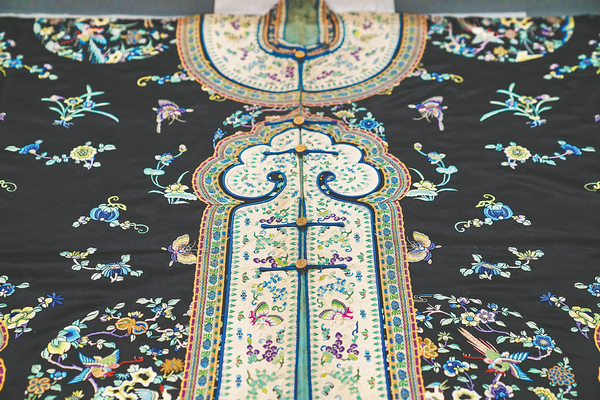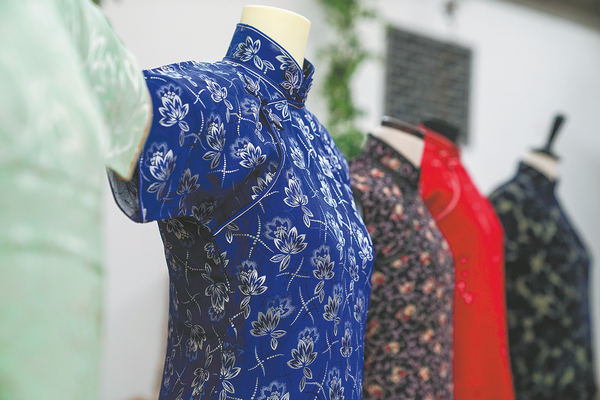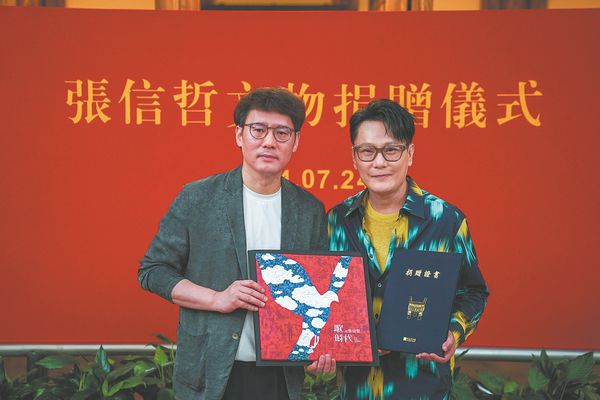
Pop singer Jeff Chang Shin-che donates 12 elegant qipao made in the 1930s and 1940s in Shanghai to the Shanghai Museum. CHINA DAILYThe'prince of love ballads'donates vintage qipao to museum to showcase their eternal appeal, Zhang Kun reports.
Jeff Chang Shin-che, known as"the prince of love ballads"in the Chinese pop music scene, donated 12 vintage qipao that he collected to the Shanghai Museum on July 24.
"I remember as a child seeing my maternal grandmother and great-grandmother. They would always dress up and put on their qipao before going out, "the singer says at the donation ceremony at the Shanghai Museum. "The memory inspired my interest in traditional Chinese clothing and that's how I started my collection. "
Born in 1967 in Taiwan, Chang began his music career in 1989. Over the past decades, he released a series of chart-topping albums and maintained his popularity across the Taiwan Strait and Southeast Asia.
Following his advancing singing career, he developed a strong interest in antiques and became a dedicated collector of vintage Chinese garments, furniture and early 1900s commercial poster calendars.
As a curator, he organized a series of exhibitions and compiled books about his collection. From May 2019 to October 2020, Chang and his team created the exhibition Min Chao, or Folk Art and Fashion, featuring rare manuscripts of calendar posters from the early 20th century, which were presented at the Aurora Museum in Shanghai.

Pop singer Jeff Chang Shin-che donates 12 elegant qipao made in the 1930s and 1940s in Shanghai to the Shanghai Museum. CHINA DAILY"From that exhibition, we noticed Chang's research and collection of modern Chinese clothing and fashion culture, especially his unique perspective on qipao, "says Yu Ying, a researcher in the handicrafts department of the Shanghai Museum.
"Qipao takes up quite an important section of my collection, "Chang says, adding that his collection totals"several thousand".
He bought some at auctions and some at antique shops in different cities. "I've collected them through many different channels, "he says. "This introduced me to other collectors and I made friends in completely different circles. "
Chang has long been in contact with the researchers of the Shanghai Museum, sometimes soliciting their professional opinions. A fanatic lover of traditional Chinese handicrafts, he is a loyal fan of the Shanghai Museum and would make private visits to the institution, where he especially enjoys the art gallery of Chinese ethnic groups.
A few years ago, he learned that Shanghai Museum needed qipao and other women's clothing pieces. Chang suggested the museum choose some items from his collection and offered to make a donation.
After many rounds of selection, the museum picked 10 pieces from Chang's collection and two garments for women that date to the Qing Dynasty(1644-1911).
All 10 pieces of qipao were made of luxurious materials such as velvet, silk and jacquard. They were hand-stitched and decorated with elaborate embroidery, bindings and knotted buttons. Three were haute couture pieces featuring renowned brands of the time in Shanghai—Sun Sun Department Store, Sincere Department Store and Dragon.
These costumes feature the"distinctive aesthetic characters and fine craftsmanship representing the artistic styles and technical achievements in the Yangtze River Delta region from the late 1800s to the early 1900s, and thus have high value for research and exhibition", reads the appraisal by a senior academic on Chinese costume history, who was invited by the museum.
The two Qing Dynasty garments could"effectively fill in the gap in the museum collection and become highly valued assets for the studies and exhibitions about Yangtze River Delta culture and the costume evolution in Shanghai, "Yu says.
Qipao, also known as Cheongsam, is a signature clothing style of women in China. It evolved from the Manchu female's long gown of the Qing Dynasty. The early 20th century saw the modernization of the qipao style, which became slender and tight-fitting.
In Shanghai, the first modern metropolis and fashion center of China, qipao was favored by women regardless of age or social status. Young, beautiful women wrapped in body-tight qipao were popular subjects on commercial poster calendars during this period. These prints were immensely popular and hung in almost every household in Shanghai and other cities.
"About one-fourth of the treasured objects at the Shanghai Museum have been donated by people from various social backgrounds, "says Chu Xiaobo, director of the museum. "We are very grateful for the love and support from Mr Chang and other donors. The garments he donated are quite representative of the Yangtze River Delta culture and Shanghai style. We plan to hold a clothing-themed exhibition next year and hopefully these donated objects by Chang will be featured. "
Also at the Shanghai Museum East, the museum's new wing on the east bank of the Huangpu River, "we have a gallery featuring the industrial achievements and handicraft innovations in the Yangtze River Delta", the director says. "We plan to showcase some costumes and accessories where Chang's donation can join the permanent exhibits. "
"Mr Chang said that he intends to make more donations and we are thankful for his generosity. I hope more people care about the development of public museums, especially the museums in China. "
Among the important categories of Chang's collection are vintage furniture from Shanghai as well as manuscripts of the poster calendars. "We are aware that these poster calendars represent an important part of commercial art in the 20th century, but few of the original manuscripts have survived, "Chang says. "I held an exhibition of these before. I think they capture an important page of China's industrial history. "
Collecting artwork has helped him find a peaceful space for himself away from busy daily work.
"Through dialogue about these objects, I have learned many interesting facts and achieved a kind of balance in my life, "he says, adding the rich cultural background of the collection has given more depth to his music and made him a better artist.


